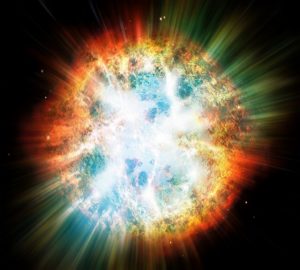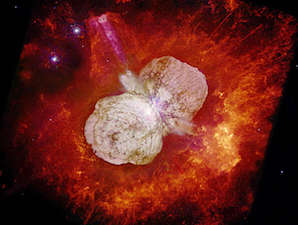Supernovae and “Guest Stars”
 On rare occasions, “new” stars can appear in our skies. These are commonly the result of stars evolving to their later stages of life. Novae, supernovae, and other types of eruptive variable stars can appear as faint, or even very bright, new stars. In Australia, we are carefully searching for accounts of supernovae in oral traditions and artistic forms. Not surprisingly, this is an extremely difficult task!
On rare occasions, “new” stars can appear in our skies. These are commonly the result of stars evolving to their later stages of life. Novae, supernovae, and other types of eruptive variable stars can appear as faint, or even very bright, new stars. In Australia, we are carefully searching for accounts of supernovae in oral traditions and artistic forms. Not surprisingly, this is an extremely difficult task!
One story may describe a supernovae. It is a story of two brothers (Nuruguya-mirri and Napiranbiru) who were fishing in a canoe when a storm hit, capsizing their boat. The elder brother was stronger and helped his younger brother reach the shore, giving his life in return. To honour the courage of the older brother, the community held a ceremony and a bright new star shone in the sky. The two brothers are now two bright stars close together in the bank of the sky-river (Milky Way, called Milnguya).
The story claims that we can still see the two bright stars and a faint star today. While the names of the stars represented by the brothers are not given, the description make it very probable that the stars are Shaula and Lesath in the Western constellation Scorpius. They are two bright stars close together in the middle of the Milky Way and are common in the oral traditions of other Aboriginal communities in the region and across Australia. In the year 393 CE, Chinese astronomers recorded a bright new star in the sky:
A guest star appeared within the asterism Wěi during the second lunar month of the 18th year of the Tai-Yuan reign period, and disappeared during the ninth lunar month. — Shen Yue, Song Shu
This is the curve of stars in the tail of Scorpius. Astronomers later found a supernova remnant in this exact part of the sky and confirmed that it is the supernova recorded in Chinese documents. It lies very close to Shaula and Lesath and could be the bright new star they describe.
Other Aboriginal traditions describe new stars appearing in the sky, but in most cases we cannot be certain if these stories are talking about an actual witnessed event or if they are symbolic representations in the story. Research conducted by Duane Hamacher explores how we can be sure if oral traditions describe these rare events.
The Great Eruption of Eta Carinae

Imagine sitting under the stars in the dry Mallee country of northwestern Victoria in the 1840s with two Aboriginal men explaining their traditions of the sky. No light pollution, no airplanes, no mobile phones, no cars… just peace, serenity, and the light of millions of stars shining above.
This is exactly what William Edward Stanbridge experienced when two men of the Boorong clan (of the Wergaia language group, claiming to have the best knowledge of astronomy of all Aboriginal groups in that region) taught him their star lore, reciting the stories as they pointed out the stars overhead. Stanbridge, an educated and wealthy British colonist, sat attentively, writing down the Boorong stars and their equivalent Western names using a star atlas. Berm-berm-gle… Alpha Centauri. Djuit… Antares. War… Canopus. When the men pointed to Collowgullouric War (the wife of War, the Crow, pronounced “Wahh”), he could not identify the bright star. Using his chart, he simply writes “Large red star in Robur Carol, marked 966. All the small stars around her are her children”, and continued to record the remaining stars.
Stanbridge read his 4-page paper on Boorong astronomy before the Philosophical Institute of Victoria in Melbourne on September 30th, 1857. Unfortunately, the institute’s office burned down a couple years later, so Stanbridge wrote a lengthier version including more non-astronomical information in 1861. His work was re-analysed in 1881 by Peter MacPherson, then again in 1996 by John Morieson, who completed an MA thesis on Boorong astronomy at the University of Melbourne.
For nearly 150 years, the identification of Collowgullouric War remained a mystery. In 2011, Duane Hamacher and David Frew published a paper in which they identified that particular star. This was no ordinary star… it is one of the most massive stars known, called Eta Carinae. This enigmatic object is actually a binary, has a combined mass of more than 100 suns, and is 4 million times more luminous than our little home star. The larger star of Eta Car is unstable and undergoes occasional violent outbursts, where it sheds material from its outer shells, making it exceptionally bright. During the 1840s, Eta Carinae went through such an outburst where it shed 20 solar masses of its outer shell and became the second brightest star in the night sky, after Sirius, before fading from view a few years later. This event, commonly called a “supernova-impostor” event, has been deemed the “Great Eruption of Eta Carinae”. The remnant of this explosion is evident by the Homunculus Nebulae. This identification shows that the Boorong had noted the sudden brightness of this star and incorporated it into their oral traditions.
Blogs & News
- Supernovae and Guest Stars (Aboriginal Astronomy Blog)
- The Enigmatic Eta Carinae and Boorong Astronomy (Aboriginal Astronomy Blog)
- Exploding star recorded in Aboriginal Dreamtime (Australian Geographic)
- Aboriginal astronomers observed and recorded a ‘supernova-impostor’ event: research (Phys.org)
- Supernovae and Indigenous Cultures (Physics Buzz Blog)
Published Research
- Hamacher, D.W. (2014). Are supernovae recorded in Indigenous astronomical traditions? Journal of Astronomical History and Heritage, Vol. 7(2), pp. 161-170.
- Hamacher, D.W. and Frew, D.J. (2010). An Aboriginal Australian record of the Great Eruption of Eta Carinae. Journal of Astronomical History and Heritage, Vol. 13(3), pp. 220-234.
